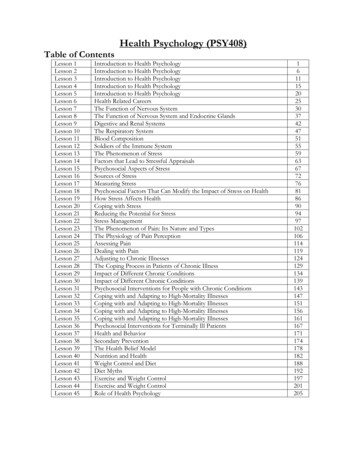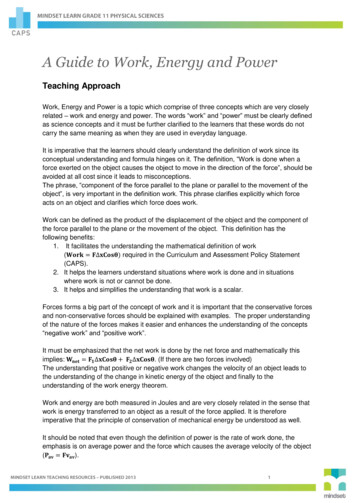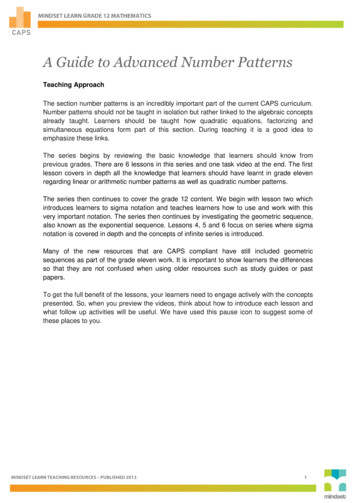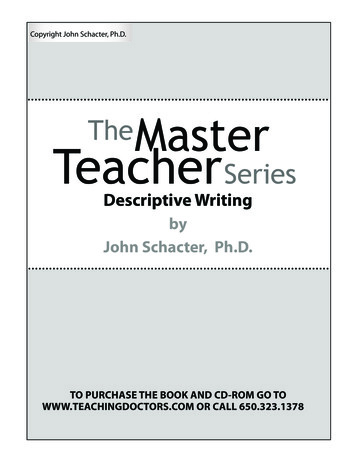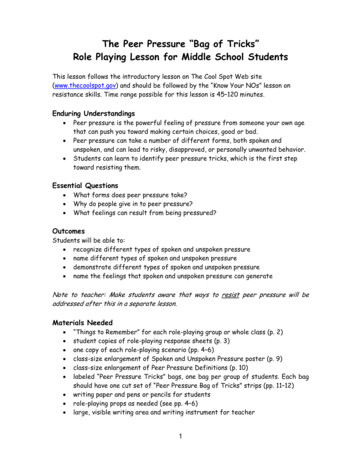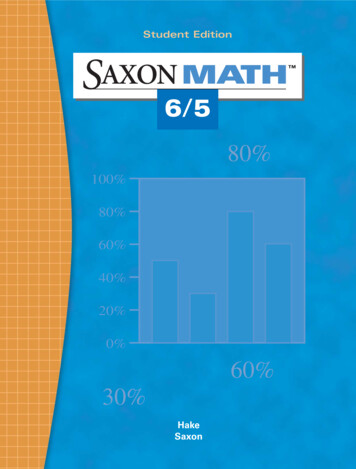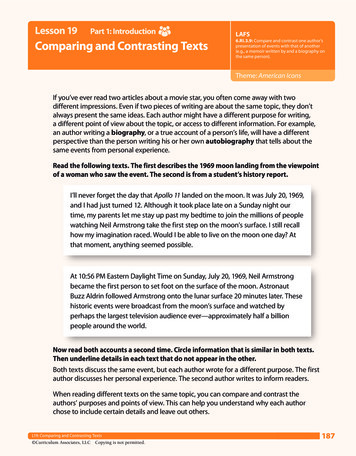
Transcription
Lesson 19Part 1: IntroductionComparing and Contrasting TextsLAFS6.RI.3.9: Compare and contrast one author’spresentation of events with that of another(e.g., a memoir written by and a biography onthe same person).Theme: American IconsIf you’ve ever read two articles about a movie star, you often come away with twodifferent impressions. Even if two pieces of writing are about the same topic, they don’talways present the same ideas. Each author might have a different purpose for writing,a different point of view about the topic, or access to different information. For example,an author writing a biography, or a true account of a person’s life, will have a differentperspective than the person writing his or her own autobiography that tells about thesame events from personal experience.Read the following texts. The first describes the 1969 moon landing from the viewpointof a woman who saw the event. The second is from a student’s history report.I’ll never forget the day that Apollo 11 landed on the moon. It was July 20, 1969,and I had just turned 12. Although it took place late on a Sunday night ourtime, my parents let me stay up past my bedtime to join the millions of peoplewatching Neil Armstrong take the first step on the moon’s surface. I still recallhow my imagination raced. Would I be able to live on the moon one day? Atthat moment, anything seemed possible.At 10:56 PM Eastern Daylight Time on Sunday, July 20, 1969, Neil Armstrongbecame the first person to set foot on the surface of the moon. AstronautBuzz Aldrin followed Armstrong onto the lunar surface 20 minutes later. Thesehistoric events were broadcast from the moon’s surface and watched byperhaps the largest television audience ever—approximately half a billionpeople around the world.Now read both accounts a second time. Circle information that is similar in both texts.Then underline details in each text that do not appear in the other.Both texts discuss the same event, but each author wrote for a different purpose. The firstauthor discusses her personal experience. The second author writes to inform readers.When reading different texts on the same topic, you can compare and contrast theauthors’ purposes and points of view. This can help you understand why each authorchose to include certain details and leave out others.L19: Comparing and Contrasting Texts Curriculum Associates, LLCCopying is not permitted.187
Part 2: Modeled InstructionLesson 19Read the following short biography of Amelia Earhart.Genre: BiographyBorn to Flyby Ann RandallAmelia Earhart didn’t always dream of becoming an aviator. While she had seen airplanesgrowing up, it wasn’t until her early twenties that she realized she was born to fly. WhenEarhart was 20 years old, she and a friend attended a stunt-flying contest. Their fun ended,however, when one of the planes came zooming toward them. In spite of the danger, Earhartstood firm, displaying the same fearlessness that she would continue to show all her life. Thisencounter proved to be a sign of things to come: just a few years later, Earhart found herselfflying inside an airplane.On December 28, 1920, pilot Frank Hawks changed Earhart’s life by taking her on her firstplane ride. It was then that she knew she was meant to be in the air. Earhart attended her firstflying lesson just five days later, and by 1922, she was already setting records: She becamethe first woman to fly to an altitude of 14,000 feet. Over the next 15 years, Earhart wouldcontinue to make her mark on the record books time and time again, proving that flying wastruly in her blood.Explore how to answer this question: “How does the author’s purpose influence the focus of the textand the details presented?”The author wants to focus on the early part of Earhart’s life to explain her passion for flying. Whichfacts has the author presented to show how Earhart’s experiences started her on the path tobecoming a famous and fearless aviator?On the lines below, explain the author’s purpose. Find evidence from the text to support youranswer.With a partner, discuss the author’s point of view about Amelia Earhart and how these feelingsare shown throughout the text. How might the author’s point of view toward Earhart haveaffected her choice of details and her presentation of events?188L19: Comparing and Contrasting Texts Curriculum Associates, LLCCopying is not permitted.
Part 3: Guided InstructionLesson 19Read another biography of Amelia Earhart. Use the Close Reading andthe Hint to complete the activity.Genre: BiographyEarhart on EqualityClose ReadingUnderline importantfacts about AmeliaEarhart that the authorincludes in thisbiography. What do theyhelp you understandabout Earhart? Whymight the author havechosen to include them?Hintby Brian VargasAs a famous female aviator, Amelia Earhart did much toadvance equality for women. In 1928, she became the firstwoman to fly across the Atlantic, and she spent the rest of herlife fearlessly flying farther, faster. Earhart was first to fly manylong, dangerous routes, and she encouraged other women to fly.She championed women in the sciences as a guest professor atPurdue University. She said, “Women must try to do things asmen have tried. When they fail, their failure must be but achallenge to others.”Fill in the chart below based on the two biographies you read.Both biographiescontain some of thesame facts, but theauthors use themdifferently. How doesthis help conveydifferent messagesabout Amelia Earhart?Write facts that are different under the title of each biography. Writefacts that are similar in the two biographies under Both.“Born to Fly”Both“Earhart on Equality”Show Your Thinking On a separate piece of paper, write two paragraphs comparing and contrasting the informationprovided in the biographies on pages 188 and 189. With a partner, discuss why these two biographies about Earhart are different. Consider theauthors’ purposes for writing, their points of view, and the information they chose.L19: Comparing and Contrasting Texts Curriculum Associates, LLCCopying is not permitted.189
Part 4: Guided PracticeLesson 19Read the following memoir and biography about Helen Keller. Use the Study Buddies and theClose Readings to guide your reading.Genre: Memoirfrom The Story of My Life1My teacher had been with me several weeks before I understoodthat everything had a name. One day, while I was playing withmy new doll, Miss Sullivan put my big rag doll into my lapalso, spelled “d-o-l-l” and tried to make me understand that“d-o-l-l” applied to both. Earlier in the day we had had a tussleover the word “m-u-g.” Miss Sullivan had tried to impress itupon me that “m-u-g” is mug and that “w-a-t-e-r” is water, butI persisted in confounding the two. In despair she had droppedthe subject for the time, only to renew it at the firstopportunity. I became impatient at her repeated attemptsand, seizing the new doll, I dashed it upon the floor. I felt myteacher sweep the fragments to one side of the hearth, andI had a sense of satisfaction that the cause of my discomfortwas removed. She brought me my hat, and I knew I was goingout into the warm sunshine.2We walked down the path to the well-house. Some one wasdrawing water and my teacher placed my hand under thespout. As the cool stream gushed over one hand she spelledinto the other the word water, first slowly, then rapidly. I stoodstill, my whole attention fixed upon the motions of her fingers.Suddenly I felt a misty consciousness as of somethingforgotten—a thrill of returning thought; and somehow themystery of language was revealed to me. I knew then that“w-a-t-e-r” meant the wonderful cool something that wasflowing over my hand. That living word awakened my soul,gave it light, hope, joy, set it free!As I read, I’ll thinkabout how Helen Keller’smemory and emotionsinfluence her writing.Close ReadingCircle words in the titleand first two sentencesthat tell you who iswriting this passage.Underline words andphrases that showKeller’s thoughts andfeelings. What do youthink she wants thereader to understand?190by Helen KellerL19: Comparing and Contrasting Texts Curriculum Associates, LLCCopying is not permitted.
Part 4: Guided PracticeLesson 19Genre: BiographyA Remarkable LifeI wonder why theauthor wanted to writethis biography of HelenKeller. I’m going to lookfor clues that help meunderstand her purpose.1For a year and a half after Helen Keller’s birth on June 27,1880, she was a healthy, bright child. She started to talk atsix months old and walked at one. However, all of thatchanged when, in February of 1882, she came down with ahigh fever. Although she survived, her family soon discoveredthat the illness had left her blind and deaf.2Young Helen found ways to cope with her new situation,such as developing a limited system of signs with a playmate.By the time she was seven, though, she had also become wildand undisciplined. Desperate, her family finally contacted thePerkins Institute for the Blind, which recommended a recentgraduate, Anne Sullivan, to work with Helen. Of course, mostpeople know the story of how Sullivan helped Helen realizethat “w-a-t-e-r” meant the liquid running over her hand.Helen learned thirty new words that first day and went on toquickly master finger signs, touch-lip reading, and Braillereading and typing.3Determined to complete college, Helen graduated with highhonors from Radcliffe in 1904; she also wrote and publishedher autobiography, The Story of My Life, in 1903. She wrote tenother books and many articles in her lifetime. Her greatestachievements, however, were her efforts to help others aroundthe country and throughout the world. Many of her visitsprompted the creation of new resources for blind and deafblind individuals. Because she could relate to people’sdifficulties, she worked with leaders to improve theirsituations. Everywhere she went, she spread a message ofstrength and courage, a legacy that stands to this day.Close ReadingWhat event is describedin Keller’s memoir onpage 190? Box theinformation about thesame event in thisbiography.Underline at least threeimportant facts that theauthor of this biographyincludes that are notpresent in Helen Keller’smemoir. How do thesefacts help you know theauthor’s purpose forwriting is different thanKeller’s?L19: Comparing and Contrasting Texts Curriculum Associates, LLCby Mary WilkesCopying is not permitted.191
Part 4: Guided PracticeHintsThink about the kinds offacts provided by eachauthor. Why do theyinclude these facts?What do they each hopeto achieve?Lesson 19Use the Hints on this page to help you answer the questions.1 How does Helen Keller’s purpose for writing her memoir differ fromthat of the biographer who wrote about her life?AHelen tries to inform people about the facts of her life, but thebiographer wants people to know about Helen’s personality.BHelen tries to explain her childhood actions, while thebiographer writes to tell people about Helen’s wild childhood.CHelen wants to reflect on her experiences, while the biographerwrites to inform people about events in Helen Keller’s life.D Helen wants to entertain people by describing her point ofview, but the biographer wants to amaze people with facts.What text did you drawa box around in thebiography on page 191?2 What event appears both in Helen Keller’s memoir and thebiography of Helen Keller?Ahow she lost both her hearing and sightBhow she learned that things have namesChow she learned to touch-read people’s lipsD how she helped the blind all over the worldWhat do you learn froma memoir that you can’tfrom a biography?How does learningabout many parts ofa person’s life in abiography help youunderstand one part?3 Describe how the two accounts of Helen Keller’s life are different.Think about the event they both describe. Explain what you learnfrom the memoir compared to what you learn from the biography.Use at least two details from the text in your response.192L19: Comparing and Contrasting Texts Curriculum Associates, LLCCopying is not permitted.
Part 5: LAFS PracticeLesson 19Read the two articles about the creation of Spider-Man. Then answer the questions that follow.Stan Lee and Spider-ManGenre: Textby Simmi Patel1 Spider-Man is a popular comic book superhero who continues to delight his fans some 50 years afterhis creation. In the autobiography Excelsior! The Amazing Life of Stan Lee, his creator, Stan Lee explains hisversion of how Spider-Man came to life.2 Stan Lee had been working in the comic book business for over twenty years. He wanted to create ahero who had a realistic life in addition to superpowers. Lee presented his idea to his boss and publisher,Martin Goodman.3 “I told Martin I wanted to feature a hero who had just a touch of super strength but his main powerwas that he could stick to walls and ceilings,” Lee says.1 Lee explained that his hero, Spider-Man, would alsobe a normal teenager. Spider-Man would be raised by his Aunt May and Uncle Ben and have all the normalproblems of an adolescent. The hero would be worried about money, allergies, girls, and anything else thatLee could think of.4 According to Lee, the creation of Spider-Man had sprung from his reading as a child. One of hisfavorite magazines was called The Spider—Master of Men, and Lee loved that name. He remembers thecharacter wearing a slouch hat and a special spider ring. If The Spider hit someone, he would leave theimpression of a spider on his victim. Although Lee remembers The Spider vividly, he clarified that thischaracter never had superpowers like Spider-Man.5 According to Lee, Martin Goodman hated his idea. Goodman felt that a superhero couldn’t be ateenager with personal problems. He said that Spider-Man seemed more like a comedy character than apowerful superhero. Since most people don’t like spiders, Goodman thought that the name “Spider-Man”was a terrible choice.6 But Lee couldn’t give up on his idea of Spider-Man. He gave artist Jack Kirby a plot line for SpiderMan and asked him to illustrate it. As Lee tells it, “Jack started to draw, but when I saw that he was makingour main character, Peter Parker, a powerful-looking, handsome, self-confident typical hero type, I realizedthat wasn’t the style I was looking for. So I took Jack off the project. He couldn’t care less because he had somany other strips to draw at the time, and Spider-Man wasn’t exactly our top-of-the-line character.”27 Lee reassigned the project to Steve Ditko, who used a more subtle and stylized style of drawing.Ditko’s rendition was exactly what Lee had in mind. They finished the comic strip, and it was published in thelast issue of Amazing Fantasy in 1962. When sales figures of that publication came in, they showed that theSpider-Man issue was a huge success. According to Lee, Goodman ran into Lee’s office to congratulate himself1Stan Lee and George Mair. Excelsior! The Amazing Life of Stan Lee (New York: Fireside, 2002) p. 126.2Lee and Mair, p. 127.L19: Comparing and Contrasting Texts Curriculum Associates, LLCCopying is not permitted.193
Part 5: LAFS PracticeLesson 19and Lee on the new character. Lee says, “I can still hear his now-classic comment, ‘Stan, remember thatSpider-Man idea of yours that I liked so much? Why don’t we turn it into a series?”’38 Spider-Man became one of the most successful comic book characters ever. When Spider-Man headedup Marvel comic books’ line of heroes, sales increased from 7 million copies in 1961 to 13 million copies in 1962.49 After Steve Ditko stopped drawing Spider-Man, artist John Romita took over. He slowly incorporatedhis own style, and Peter became tall and handsome as he grew up. The characters gradually took on a newlook, and the Spider-Man comic strip continued to increase in popularity.3Lee and Mair, p. 128.4Lee and Mair, p. 132.The Birth of Spider-Manby Max Bruno1 What do you think of when you hear the name Spider-Man? A superhero who can cling to almostanything? Devices that shoot spider webs? A “spider sense” to outwit enemies?2 Since his appearance in the early 1960s, Spider-Man has been different than other comic booksuperheroes. Initially, he was a teenager who had to deal with loneliness, rejection, and other realisticproblems. Over the years, Peter Parker went to college, got married, taught high school, and became afreelance photographer. By 2011, he had become a member of two superhero teams, the Avengers and theFantastic Four. But how did Spider-Man crawl into existence?3 In his autobiography, Excelsior! The Amazing Life of Stan Lee, Lee explains his version of the birth ofSpider-Man. Stan Lee had been working in the comic book business since 1939. Lee always wanted to be awriter, and he began by writing comic book text filler. Later, he wrote features and became an editor before hewas 20. According to Lee, he had been trying to develop a superhero who also needed to deal with the normalproblems of daily life. He presented his idea to his boss, Martin Goodman. Lee maintains that Goodmanthought Spider-Man was a terrible idea.4 Lee claims he asked artist Jack Kirby to illustrate his plot line but later reassigned the job to artistSteve Ditko. Lee liked Ditko’s stylized approach. The comic strip was published in 1962, and it became a hugesuccess.5 Others, however, have called Lee’s version of events into question. In the book Stan Lee and the Riseand Fall of the American Comic Book, authors Jordan Raphael and Tom Spurgeon take a different viewpoint.They claim that the original Spider-Man was the result of the work of several artists and writers. Stan Leewanted to create a spider superhero, but artist Jack Kirby also wanted to draw an insect superhero. Raphaeland Spurgeon explain, “Stan Lee expressed the desire to do a teenage superhero using the spider motif. JackKirby had long wanted to do an insect-related superhero.” Kirby started to put together a slightly differentversion of the tale. He rejected “some of the more fantastic Lee story elements,” instead adding “a kindly auntand uncle, and giving the superhero a secret origin revolving around a neighbor who happened to be a scientist.”11Jordan Raphael and Tom Spurgeon, Stan Lee and the Rise and Fall of the American Comic Book (Chicago Review Press, 2003), p. 93.194L19: Comparing and Contrasting Texts Curriculum Associates, LLCCopying is not permitted.
Part 5: LAFS PracticeLesson 196 The character of Spider-Man was eventually given to artist Steve Ditko. He worked from a storysummary and Kirby’s ideas, and eventually he created the drawings of Spider-Man and Peter Parker with“bottle-thick glasses, slumped shoulders, and a homemade costume. Ditko was nearly as sharp as Kirby whenit came to shaping characters in ways that would make them effective on the page. The Spider-Man millions ofreaders came to know and love got his youth and voice from Stan Lee and his human frailty from SteveDitko.”2 And the first cover drawing of Spider-Man was drawn by Jack Kirby.7 According to Raphael and Spurgeon, Lee often built on contributions from other artists. Comic bookpublishers tried to produce as many books as possible in a short amount of time, and Lee encouragedeveryone to contribute ideas. As more writers and artists were hired, everyone shared ideas. Later, legal andfinancial questions arose regarding who actually created which comic book character. But during the early1960s, superhero comic books flourished through this collaborative process.2Raphael and Spurgeon, pp. 93–94.Answer Form12How does the author’s purpose for writing the first article,“Stan Lee and Spider-Man,” differ from the author’spurpose for writing “The Birth of Spider-Man”?1 A B C D2 A B C D3 A B C DNumberCorrect3AThe first author describes Stan Lee’s version of the creation of Spider-Man. The secondexplains that there are different versions of how Spider-Man was created.BThe first author wants readers to understand why Stan Lee is so popular. The secondwants readers to understand why Spider-Man is so popular.CThe first author wants readers to reflect on Stan Lee’s point of view. The second wantsreaders to reflect on facts about Stan Lee’s career.DThe first author wants to describe Stan Lee’s vision of Spider-Man. The second wants todescribe Jack Kirby’s vision of Spider-Man.What did both authors want the reader to understand about Martin Goodman and thecreation of the Spider-Man character?AMartin Goodman headed the team who developed the Spider-Man concept.BMartin Goodman respected Stan Lee’s decisions as a writer.CMartin Goodman shaped the character to make him effective on the page.DMartin Goodman didn’t deserve credit for the creation of Spider-Man.L19: Comparing and Contrasting Texts Curriculum Associates, LLCCopying is not permitted.195
Part 5: LAFS Practice34Lesson 19Which fact appears in both articles?AMartin Goodman felt that the name “Spider-Man” was a terrible choice.BSpider-Man was probably the result of several writers’ ideas.CSteve Ditko created the art for the character of Spider-Man.DJack Kirby also wanted to create a superhero that looked like an insect.Compare and contrast the way the two authors present information about Spider-Man inthese articles. Describe similarities and differences in the authors’ purposes, their points ofview, and the facts they chose. Use at least four details from the articles to supportyour response.Self Check Go back and see what you can check off on the Self Check on page 177.196L19: Comparing and Contrasting Texts Curriculum Associates, LLCCopying is not permitted.
about how Helen Keller’s memory and emotions influence her writing. Read the following memoir and biography about Helen Keller. Use the Study Buddies and the Close Readings to guide your reading. from The Story of My Life by Helen Keller 1 My teacher had been with me seve





